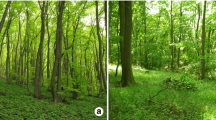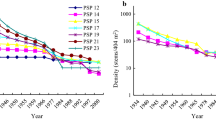Abstract
Hurricane Dean, a category 4 storm, impacted the forests along the western coast of Martinique on August 17, 2007. In March 2008, plots were selected in the rainforest of the Plateau Concorde, which presented a range of post-hurricane damage. The study focused on climber community patterns in two extreme ranges of disturbance (HIP: highly damaged plots; LIP: lightly damaged plots). The objectives of the study were to i) obtain data on forest architecture and light regime, ii) determine the species diversity and abundance among climbers, and iii) identify recurrent patterns of association among traits within this flora. Fisheye photos showed significant differences in canopy geometry and light microclimate between HIP and LIP. One transect in each extreme range of disturbance showed that the floors were similarly covered but the distribution of foliar density in the vertical structure was evenly distributed from the floor to the canopy in LIP and was exclusively concentrated within the first meter in HIP. Five hundred and eleven climbers were counted, measured and identified in 12 plots (30 m × 30 m). Correspondence analysis of the selected traits revealed four functional groups (C1 to C4). C1 and C2 included understory climbers and C3 and C4 were composed of overstory climbers showing differences in stem or leaf nature. We identified eight species among the 161 trees >5 cm dbh (diameter at breast height) assessed in the 12 plots supporting climbers. A linear regression showed that large trees were more colonized than smaller trunks. The mean number of climbers per host trunk was 2.7, with no significant difference between HIP and LIP plots. In spite of the great differences in forest architecture, canopy openness and light regime, the 16 climber species were present in all plots. Five species, all belonging to one of the four functional groups, varied in abundance. In the HIP plots, the dramatic expansion of Cayaponia americana (C1), a ruderal plant frequently observed at lower altitudes, was noteworthy. Our results suggest that climbers present highly efficient morphological adaptations to hurricanes. Indeed, they are mostly linked to a single host, they strongly reiterate after breakage, and they show low clumping.





Similar content being viewed by others

References
Acevedo-Rodriguez P (2005) Vines and climbing plants of Puerto Rico and the Virgin Island. Smithsonian Institution, Contributions from the United States National Herbarium, National Museum of Natural History, Washington, DC
Allen BP (2007) Vegetation dynamics and response to disturbance of floodplain forest ecosystems with a focus on lianas. PhD Thesis, Ohio State University, Columbus, Ohio
Allen BP, Pauley EF, Sharitz RR (1997) Hurricane impacts on liana populations in an old-growth south-eastern bottomland forest. J Torrey Bot Soc 124:34–42
Allen BP, Sharitz RR, Goebel PC (2005) Twelve years post-hurricane liana dynamics in an old-growth south-eastern floodplain forest. Forest Ecol Managem 218:259–269
Basnet K, Likens G, Scatena FN, Lugo AE (1992) Hurricane Hugo damage to a tropical rain forest in Puerto Rico. J Trop Ecol 8:47–55
Battaglia L, Sharitz R, Minchin PR (1999) Patterns of seedling and overstory composition along a gradient of hurricane disturbance in an old-growth bottomland hardwood community. Canad J Forest Res 29:144–156
Brokaw NV, Grear JS (1991) Forest structure before and after Hurricane Hugo at three elevations in the Luquillo Mountains, Puerto Rico. Biotropica 23:386–392
Chazdon RL, Fetcher N (1984) Photosynthetic light environments in a lowland tropical rain forest in Costa Rica. J Ecol 7:552–564
Chinea JD (1999) Changes in the herbaceous and vine communities at the Bisley experimental watersheds, Puerto Rico, following Hurricane Hugo. Canad J Forest Res 29:1433–1437
Diaz S, Cabido M (1997) Plant functional types and ecosystem function in relation to global change. J Veg Sci 8:463–474
Ewers FW, Fisher JB, Fechtner K (1991) Water flux and xylem structure in vines. In Putz F, Mooney HA (eds) Biology of vines. Cambridge University Press, Cambridge pp 119–152
Fernandez DS, Fetcher N (1991) Changes in light availability following Hurricane Hugo in a subtropical montane forest in Puerto Rico. Biotropica 23:393–399
Fiard JP (1994) Les forêts du nord de la Montagne pelée et des édifices volcaniques du Piton, Mont Conil et du Morne Sibérie, Martinique. PhD Thesis, University of the Antilles and Guyana
Fisher JB, Ewers F (1991) Structural responses to stem injury in vines. In Putz F, Mooney HA (eds) Biology of vines. Cambridge University Press, Cambridge, pp 99–124
Fournet J (2002) Flore illustrée des phanérogames de Guadeloupe et de Martinique. 2 tomes. Cirad, editions Gondwana, Montpellier
Frazer S (1999) Gap light analyzer (GLA). Users manual and programme documentation, Version 2.0. Available at: http://www.rem.sfu.ca/forestry/downloads/Files/GLAV2UsersManual.pdf
Gerwing JJ, Schnitzer SA, Burnham RJ, Bongers F, Chave J, DeWalt SJ, Corneille EN, Foster R, Kengack D, Martineza-Ramos M, Parren M, Parthasarathy N, Perez-Salkicrup DR, Putz FE, Thomas DW (2006) A standard protocol for liana censuses. Biotropica 38:256–261
Givnish TJ, Vermeij G (1976) Size and shapes of liana leaves. Amer Naturalist 110:743–778
Horvitz CC, Koop A (2001) Removal of non native vines and post-hurricane recruitment in tropical hardwood forests of Florida. Biotropica 33:268–281
Imbert D, Labbe P, Rousteau A (1996) Hurricane damage and forest structure in Guadeloupe, French West Indies. J Trop Ecol 12:663–680
Labbe P (1994) Régénération après passage du cyclone Hugo en forêt dense humide de Guadeloupe. Acta Oecol 15:301–315
Lee DW, Richards JH (1991) Heteroblastic development in vines. In Putz F, Mooney HA (eds) Biology of vines. Cambridge University Press, Cambridge, pp 205–244
Lepš J, Šmilauer P (2003) Multivariate analysis of ecological data using Canoco. Cambridge University Press, Cambridge
Lodge D, McDowell WH (1991) Summary of ecosystem-level effects of Caribbean hurricanes. Biotropica 23:373–378
Londre RA, Schnitzer SA (2006) The distribution of lianas and their change in abundance in temperate forests over the past 45 years. Ecology 87:2973–2978
Matthews R, Mackie ED (2006) Forest mensuration: a handbook for practitioners. HMSO, Edinburgh
Mooney H.A, Gartner B.L. (1991) Reserve economy of vines. In Putz F, Mooney HA (eds) Biology of vines. Cambridge University Press, Cambridge, pp 161–180
Oldeman RAA (1990) Forests: elements of silvology. Springer-Verlag, Berlin, Heidelberg, New York
Ostertag R, Silver WL, Lugo AE (2005) Factors affecting mortality and resistance to damage following hurricanes in a rehabilitated subtropical moist forest. Biotropica 37:16–24
Parde J, Bouchon J (1988) Dendrométrie. Ed. 2. Ecole Nationale du Génie Rural des Eaux et Forêts, Nancy
Philips OL, Gentry AH (1994) Increasing turnover through time in tropical forests. Science 263:954–958
Philipps OL, Vasquez-Martinez R, Monteagudo RA, Mendoza A, Baker TR, Nunez-Vargas A (2002) Large lianas as hyperdynamic elements of the tropical forest canopy. Ecology 86:1250–1258
Rice K, Brokaw N, Thompson J (2004) Liana abundance in a Puerto Rican Forest. Forest Ecol Managem 190:33–41
Schnitzer SA (2005) A mechanistic explanation for global patterns of liana abundance and distribution. Amer Naturalist 166:262–276
SigmaPlot (2006) SigmaPlot for Windows. Ver. 10. Systat Software, Point Richmond
Steudler PA, Melillo JM, Bowden RF, Castro MS, Lugo AE (1991) Effects of natural and human disturbances on soil nitrogen dynamics and trace gas fluxes in a Puerto Rican wet Forest. Biotropica 23:348–355
Ter Braak CJF, Šmilauer P (2002) CANOCO Reference Manual and CanoDraw for Windows User’s Guide: Software for Canonical Community Ordination (version 4.5). Microcomputer Power, Ithaca, NY
Uriarte M, Canham CD, Thompson J, Zimmerman JK, Brokaw N (2005) Seedling recruitment in a hurricane-driven tropical forest: light limitation, density-dependence and the spatial distribution of parent trees. J Ecol 93:291–304
Walker LR (1991) Tree damage and recovery from Hurricane Hugo in Luquillo Experimental forest, Puerto Rico. Biotropica 23:373–378
Walter JM, Riera B, Cournac L, Dubois MA (2001) Indice foliaire en forêt sur pente : l ’Inselberg des Nouragues, Guyane Française. Conference ECOFIT «Modélisation en Environnement », Cargèse 12–16 March 2001, Modélisation en Environnement. Institut d’Études Scientifiques de Cargèse, Corse. Service de Physique de l'Etat Condensé CEA 91191 Gif-sur-Yvette. Actes sur CD-ROM Dubois, CEA
Wright SJ, Calderon O, Hernandez A, Paon S (2004) Are lianas increasing in importance in tropical forests ? A 17-year record from Panama. Ecology 85:484–489
Author information
Authors and Affiliations
Corresponding author
Rights and permissions
About this article
Cite this article
Schnitzler, A., Arnold, C., Fiard, JP. et al. Post-Hurricane Responses of Climbers in a Tropical Mountain Rain Forest of Martinique. Folia Geobot 47, 277–291 (2012). https://doi.org/10.1007/s12224-011-9117-6
Received:
Accepted:
Published:
Issue Date:
DOI: https://doi.org/10.1007/s12224-011-9117-6



